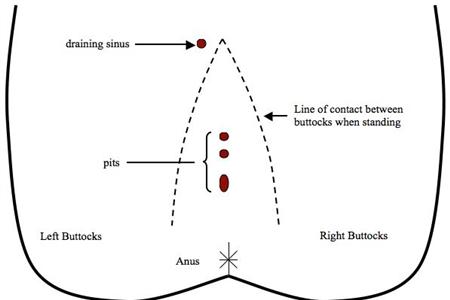About Pilonidal
Pilonidal Disease
HEAL© Procedure
Testimonials
Your First Visit
Pilonidal Disease
Pilonidal disease is a commonly occurring condition that can lead to an infection of the skin in the region of the buttock crease. It is usually due to ingrown hair. They can affect people at any age, but usually strike young people, more commonly males. They usually will not go away on their own, and antibiotics alone will generally not solve the problem.
Symptoms vary from a draining dimple to a severely infected abscess. An abscess is generally treated with immediate drainage to provide relief. The condition may require further surgery to resolve the condition, as about half will continue to drain or recur after the initial drainage. The type of surgery done can greatly affect how long it will take to recover, the type of post-operative care it will require and the chance of it returning.
Surgery for pilonidal cyst can range from removal of the enlarged hair follicles (referred to as “pits”), complete removal of the cyst, or cleft lift procedure. The wound can be left open or closed, depending on the situation and the preference of the surgeon. Open wounds often take longer (up to 2 months) to heal & require daily wound care. The advantage is a lower chance that the cyst recurs (approximately 5% chance). Closed technique often is more complex surgery, but can result in quicker healing (approximately 2 weeks) & recovery, with a slightly increased risk of recurrence (approximately 9% chance). Cleft lift surgery elevates the crease between the buttock resulting in a decreased chance of recurrence.
Over many years of experience, I have become an expert in cleft lift surgery and this is what I find gives the best results, the quickest healing & most satisfaction from the thousands of patients that I have treated. I am sure I can do the same for you.
HEAL© PROCEDURE
The HEAL procedure includes the following steps
- Remove all the hair & granulation tissue (that’s what surgeons call the stuff that bleeds a lot). This often requires opening up the skin a fair amount to uncover the entire cyst.
- Limited excision of the cyst wall. This preserves tissue to makes it easier to close. Rarely is removing tissue “down to the bone” necessary.
- Lift the skin edges of the inner part of the cleft to soften the crease between the buttocks, allow the skin to be closed & reduce the chance of hair getting caught in this space again.
- Placing a drain for a few days to remove fluid is sometimes necessary.
- Carefully dress the area to give it the best chance to heal properly.

Your Path to Treatment Starts Here
Flexible appointments and Televisits.
Email Or Call —856.429.8030
A Better Approach to Pilonidal Disease
Advocare Colon & Rectal Surgical Specialists
701 Cooper Road Suite #11, Voorhees Township, NJ 08043
856.429.8030
info@PilonidalSurgeon.com
Advocare Colon & Rectal Surgical Specialists
188 Fries Mill Rd suite K-2, Turnersville, NJ 08012
856.262.7340
info@PilonidalSurgeon.com

